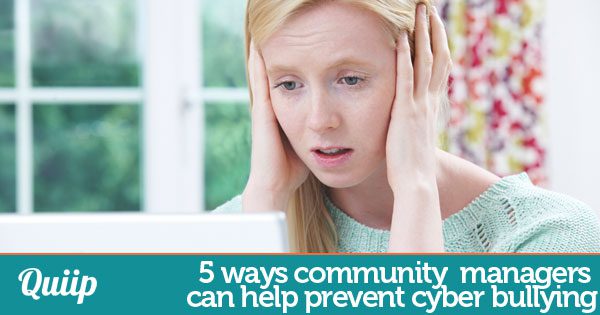5 ways community managers can help prevent cyber bullying
Twenty percent of young Australians aged 8–17 experience cyber bullying. Victims of cyber bullying are at four times the risk of depression and twice as likely to self-harm. Other long-lasting effects include a higher risk of theft, school suspension, binge drinking, and drug use. And, of course, we know cyber bullying can drive young people to suicide. Who can forget the tragic loss of 13-year-old Sydney girl Madeleine Milne in 2013 or the heart-wrenching video that British Columbia teen Amanda Todd posted to YouTube just a month before she killed herself in 2012?
Cyber bullying has become the most prevalent form of bullying young people experience. Today is the National Day of Action against Bullying and Violence, a day in which we focus on the message that bullying and violence are not okay. It is an opportunity for us to stand together against bullying and violence.
Community and social media management is about more than just posting content and moderating naughty comments. At Quiip, we often work with communities of people struggling with social injustices and mental health issues. As community managers, we must be committed to the safety of those who participate in our communities and to providing a safe space for them to talk about their experiences. There is no place in our communities for cyber bullying.
Here are 5 ways that we help prevent cyberbullying and you can too.
1. Be familiar with key legislation
Earlier this month, the Parliament passed the Enhancing Online Safety for Children Act 2015, legislation which establishes the office of the Children’s e-Safety Commissioner as an independent statutory office within the Australian Communications and Media Authority and grants powers to that office. Alastair MacGibbon has been appointed to the role of Children’s e-Safety Commissioner by the Federal Government.
Mark Pearson is Professor of Journalism and Social Media at Griffith University in Queensland. At his blog, he has a number of useful links to criminal frameworks, key legislation, and case studies.
2. Know the standards and limitations of your community and social platforms
This should be obvious. You should know the community standards and you should enforce them. This isn’t always easy on social networks where you may not have the final call on the type of content that appears and where you might not have easy or direct access to a member who needs help.
3. Advocate for better resources
Facebook recently updated its community standards and is introducing suicide prevention and support tools. Twitter CEO Dick Costolo recently admitted to being embarrassed for the company’s failure to take strong action against trolls.
“We suck at dealing with abuse and trolls on the platform and we’ve sucked at it for years. It’s no secret and the rest of the world talks about it every day. We lose core user after core user by not addressing simple trolling issues that they face every day.”
It’s important that we continue speaking out and demand a better response to cyber bullying.

4. Establish and continue to develop strategies and governance around adverse events
Your documentation needs to include a strategy for how to handle adverse events such as threats and disclosures of suicide ideation. These should include taking every threat seriously, appropriate responses, response time, intervention, what to document, how to weight the safety of one person against the safety of the entire community, and when to contact police.
5. Ensure ongoing training and self-care for community managers
Community management is one thing and safety is another, but in our world, these are intertwined. While we can’t expect community managers to be experts on safety, communications, laws, and mental health, we can provide them with resources to help them recognise, respond, and refer appropriately.
Self-care is very important for community managers. The myriad challenges that comes with this work can deplete their inner resources and result in vicarious trauma, compassion fatigue, and stress, which lead to burnout. Community managers often work long hours, after hours, and holidays. So, it’s essential that they get enough time off and that they have a supportive work environment and a personal support network.
How do you help keep your community free of bullying?
